With regards to homebuying, everybody knows the basic principle: Don’t buy more house than you can manage. Be that as it may, what establishes “moderate” will contrast starting with one purchaser then onto the next. As of September 2019, the normal cost for another house was nearly $363,000, which means a few people pay much more than that, and others significantly less. Any place you fall on the range, all things considered, a home will add up to one of the biggest single buys you will ever make.
Making sense of the sweet spot of reasonableness requires more than getting a preapproval letter from a home loan bank, be that as it may. First-time buyers will in general shop on the sum a bank is happy to propel them, not considering different costs. That sets them up for money related hardship and even a foreclosure in the event that they can’t bear the cost of the regularly scheduled installment.
KEY TAKEAWAYS
Setting a homebuying spending plan includes beyond what checking whether you can swing a home loan installment.
To decide whether a house is reasonable, figure your whole obligation to-pay proportion: all your month to month costs isolated by your gross pay.
Homeownership includes an assortment of progressing costs, including mortgage holders’ protection, property assessments, and fix/upkeep costs.
Bearing a home methods having the option to make in any event a 20% initial installment on it; else, you’ll acquire exorbitant private home loan protection.
The 25% Rule Can Get You Started
Probably the most straightforward approaches to figure your homebuying spending plan is the 25% principle, which directs that your home loan shouldn’t be over 25% of your gross pay every month. The Federal Housing Authority is more liberal, permitting buyers to spend up to 29% of their gross salary on a home loan. However, remember that, on the off chance that you have different obligations, you should think about them, notwithstanding the home loan installment, to decide the amount you can genuinely bear.
Home loan banks take a gander at this general figure—a planned borrower’s obligation to-pay proportion—while deciding whether they will loan cash. Suppose your month to month contract installment is $1,000 every month and your different costs are $1,000, so generally speaking, your month to month commitments come to $2,000. Presently suppose you have a gross month to month salary of $6,000. That puts your obligation to-pay proportion at
33%.
43%
For the most part, the most elevated obligation to-salary proportion a borrower can have and get a home loan from a certified moneylender.
Homeowning Expenses Beyond the Mortgage
Getting pre-endorsed for a home advance is a significant initial phase in the homebuying procedure, however it is just a single thought. A home loan isn’t the main repeating cost: homeownership accompanies a ton of other continuous costs, which purchasers need to envision. These incorporate mortgage homeowners’ insurance, utilities, fixes, and upkeep costs. Support alone can include: The grass should be cut, the snow must be scooped, and the leaves raked. Purchasers likewise need to consider property charges.
Those expenses, just as the other normal costs, must be incorporated while deciding how much home you can manage. Those costs can add enormously to the month to month expenses, making a home that appeared to be moderate on paper expensive as a general rule. A $1,500-per-month contract installment might be agreeable, yet include $1,500 in month to month costs, and out of nowhere your commitments have multiplied.
Initial installment Should Dictate the Purchase
For the most part, moneylenders need homebuyers to have the option to pay at any rate 20% of the price tag in real money. In the event that they can just make an up front installment underneath that sum, they can at present get a home loan, yet frequently should likewise bear the additional cost of private mortgage insurance (PMI). Paying PMI implies their month to month contract installment will go up by somewhere in the range of 0.3% to 1.2% of the advance sum.
The amount you pay in PMI will rely upon the size of the home, your credit score and FICO rating and the potential for the property to acknowledge, in addition to other things. In the event that you can’t swing $60,000 down on a $300,000 home, go for in any event 10%. The more up front installment, the less intrigue you’ll pay over the life of the advance, and the littler your month to month contract installment will be, regardless of whether you are hit with contract protection.
The sum you put something aside for the initial installment ought to likewise impact the house you purchase. On the off chance that you have enough to put 20% on one home however 10% on another, the less expensive home will give you all the more value for your money.
Purchasers likewise need to save cash for shutting costs, which can add up to somewhere in the range of 2% and 5% of the price tag, contingent upon which state you live in. On the off chance that you are buying a $200,000 home, you could pay somewhere in the range of $4,000 and $10,000 in shutting costs alone. The less you need to fund in the credit, the lower premium you will pay over the life of the advance, and the sooner you’ll see an arrival on your venture.
Pick a Property You Can Handle
While thinking about the reasonableness of the home, first-time purchasers need to think about the condition of the property and the size. All things considered, enormous isn’t in every case great, particularly if warming and cooling it breaks the spending limit. A curious home sitting on a pleasant slope might be a fantasy materialized, yet scooping that long, soak carport throughout the winter months could be an exorbitant bad dream. So could that 3,000-square-foot fixer-up, which appears to be overly modest until you need to begin revamping each room in the house. See service bills for the properties you’re thinking about—and have a development master gauge what setting it up could cost. In case you’re wanting to do it for the most part yourself, be reasonable about what you can deal with, both as far as ranges of abilities and as far as time.
The Bottom Line
Homeownership is as yet the American dream, however it can rapidly transform into a bad dream on the off chance that you err your buy. First-time purchasers, specifically, have a ton of needs, frequently beyond what they can really deal with. They should ensure that the house they buy is reasonable by considering something other than the month to month contract installment. Without some forthright estimations, they can end up house-rich however money poor, prompting a wide range of monetary agony. Require some investment time to cost out your fantasy before you sign for it.




